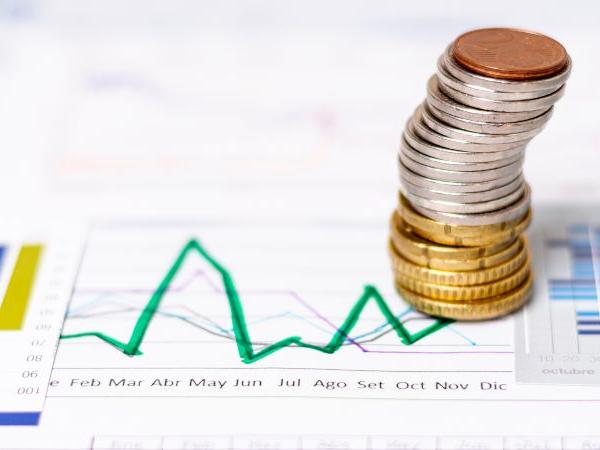Without a doubt, the data from the Economic Monitoring Index for November fell like a bucket of cold water in the local market, given that based on the results of October, the optimism of the analysts was high and the projections pointed very close to 2%, which were not only breached, but were far away and The alerts were raised again for the consolidated growth of 2024.
The balance sheet for the eleventh month of last year reaffirms a truth that had been mentioned in the various reviews of the economy: the pace of growth is slowing down and it is necessary to implement a reactivation plan that focuses mainly on industry and construction. , but that also promotes the good pace that trade has brought since the beginning of the third quarter.
Economic growth
iStock
Portafolio consulted five analysts and study centers about this result, in order to know its genesis and the factors that could have influenced it. Although aspects were mentioned such as the high comparison base that 2023 brought and the already known problems in sectors that are not doing well, the debate was opened on the impacts of the cuts in public spending that the National Government began.
Lower domestic demand
One of the first points of view was that of Anif, a study center economic where they attribute the slowdown to the weakening of key sectors such as agriculture, industry and construction, affected by lower internal demand and structural problems; although they highlight that in the accumulated period from January to November, things are not going so bad.
“When analyzing the results by type of activity, it is observed that primary activities decreased 1.7% annually in November, after registering an annual growth of 4.5% in October. Lower domestic demand was evident, although this was partially offset by exports and limited the fall,” they explained.
Read here: Debt of more than $1 billion from Invías puts 57 road projects in danger, says the CCI
Based on this, Anif emphasized the need for targeted policies to reactivate these strategic sectors, warning that the heterogeneity of growth threatens long-term economic sustainability.in a context where the fiscal crisis has the confidence of investors in check.
Meanwhile, for Andrpes Langebaek, director of Economic Studies at Davivienda, the first thing to make clear is that it was a surprise fact. Likewise, he highlighted that sectorally, there is not a single activity that can explain the performance, since six of the nine branches of activity ended up in red.
“In any case, we can refer to the three that exerted the greatest burden: public administration, defense, education and health, together with artistic and entertainment activities; secondary activities (made up of construction and industry) and primary activities (made up of the agricultural and mining and quarrying sectors),” he stated.

Colombian pesos
iStock
The muscle of the Government
One part of the analysis made by Langebaek that drew attention is that from his perspective, behind this contraction in growth “is the fact that, due to the spending cuts made by the government, motivated by the low collection that has faced, has been forced to reduce the activity of the sector in the added value that is measured in the national accounts, the amount of spending carried out by the public administration and its evolution in real terms weighs significantly.
Camilo Pérez, head of Economic Research at the Bank of Bogotá, thinks the same, who accepts that the slowdown is generalized, but warns that the fact that fewer resources are being injected into the economy from the National Government, is leading to a loss of strength in the economic dynamics.
Other news: Compensar EPS will not completely leave the health system and will only work in Bogotá
“We do consider that behind this slowdown in the public sector there is surely something about the issue of spending restriction and fiscal situation that was so evident at the end of last year and that limits growth a little, but as I mentioned, the tendency to slowdown is a little more generalized,” he explained.
Meanwhile, Juan David Robayo, Economic Research analyst at Itaú Colombia, He maintains that public spending is a dynamic to which greater attention must be paid and asks to also review what is happening in sectors such as mining and industry, as well as the slowdown in agriculture.
“As observed in the growth report for the third quarter of 2024, public spending has been presenting weak dynamics, which surely continued in November with the spending cuts that the government has made to achieve compliance with its fiscal goals and therefore both lagging behind the economic activity data,” he stated.

Recession
PHOTO: iStock
What’s coming now?
Regarding what to expect after the November data, for the 2024 consolidated that will be released in January, Robayo indicated that “this raises alarm bells for some key sectors such as agriculture, which had a very favorable performance throughout the year. However, among the positive aspects of the data was the expansion of the commerce sector, which reflected that the dynamism of the country’s internal demand is once again gaining traction.”
Finally, Julio Romero, Chief Economist of Corficolombiana, warns that although things are not at a point of no return and that there will indeed be a positive variation in GDP at the end of 2024, whether there is good data or not will depend a lot on what that happens in December and that a minimum level of 2% is reached.
You may be interested: What powers will Petro cease to have when the state of economic emergency is ruled out?
“I think it is possible, we have to wait until we have more information“Although in fact the November data was bad and in summary it went through a more negative construction than expected, for entertainment also surprising the decline, but there are still some sectors that are having a very positive reactivation,” he highlighted.
Due to all of the above, analysts emphasize the need to adopt measures that promote strategic sectors such as construction, mining and public administration, which have shown weakness during the year, and focus efforts on stimulating private investment, expediting the execution of infrastructure projects and promote policies that boost domestic consumption.
All without forgetting that greater fiscal stability and regulatory clarity will be essential to restore business confidence and strengthen economic growth in 2025.

















